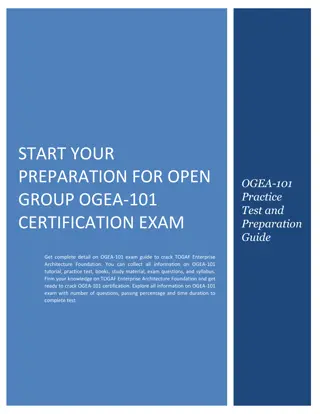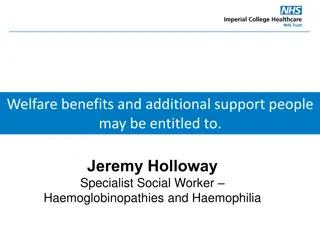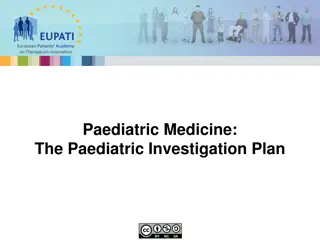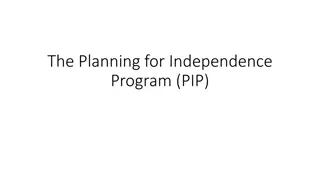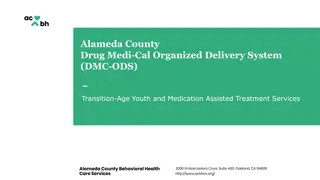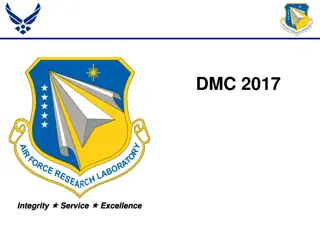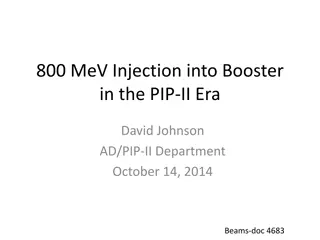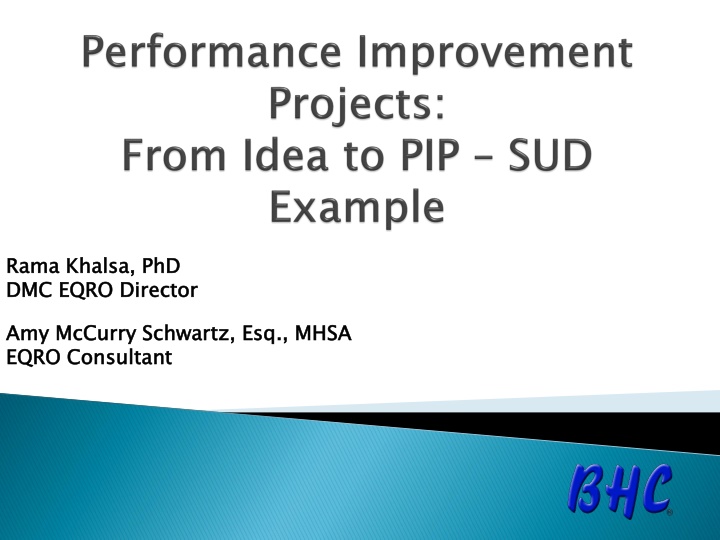
Continuous Quality Improvement in Substance Use Disorder Treatment
Learn about the importance of Continuous Quality Improvement (CQI) in substance use disorder treatment, the role of Quality Improvement Plans (QIPs) in identifying and addressing issues, and how to foster a culture of quality improvement for better client care outcomes.
Download Presentation

Please find below an Image/Link to download the presentation.
The content on the website is provided AS IS for your information and personal use only. It may not be sold, licensed, or shared on other websites without obtaining consent from the author. If you encounter any issues during the download, it is possible that the publisher has removed the file from their server.
You are allowed to download the files provided on this website for personal or commercial use, subject to the condition that they are used lawfully. All files are the property of their respective owners.
The content on the website is provided AS IS for your information and personal use only. It may not be sold, licensed, or shared on other websites without obtaining consent from the author.
E N D
Presentation Transcript
Rama Khalsa, PhD DMC EQRO Director Rama Khalsa, PhD DMC EQRO Director Amy McCurry Schwartz, Esq., MHSA EQRO Consultant Amy McCurry Schwartz, Esq., MHSA EQRO Consultant
DMC-ODS PIP Training Module 2 Here we will be building on the information we provided in the PIP 101 training from October 2016 which is on our web site www.caleqro.com if you missed it. Today we will be applying real concepts from the last training, to clinical practice in the field of substance use disorder treatment using an example from one of the counties. Examples are helpful to see how others have tackled problems using the PIP process for continuous quality improvement.
Continuous Quality Improvement (CQI) is defined as the systematic review of ... Fostering a QI culture means having: * An understanding and commitment from all staff that improving quality and solving clinical and administrative problems to improve client care and outcomes is everyone s job. To do this health systems have: Quality Improvement staff decided to this activity, and A Quality Improvement Plan (which looks at issues systematically throughout the care system; and QI structure and processes in place which are understood by the staff and its clients. You have an issue, challenge, barrier or opportunity for improvement what is it? Issues should routinely be identified through process of reviewing and analyzing data or looking at clinical problems or concerns, taking input from staff and community and most important the clients you serve! How does an identified issue get raised to the level of a PIP? It should be referred to the Quality Improvement program and management where it can be studied as possible PIP. PIP topics should be selected based on issues raised and studied using the Quality Improvement process and data and other analytic resources. Why use the PIP process? PIP topics should be selected based on issues raised and studied using the Quality Improvement process and data and other analytic resources. Why use the PIP process? PIP process provides a systematic structure and approach to investigating causal factors and designing effective interventions and evaluating if they work.
How are new ideas generated in your substance use treatment system? Identify and raise issues that need to be improved based on clinical practice and operational systems and DATA! Move from idea to implementing a new clinical effort or operational change to benefit clients. Ultimately it must be about improving clients experience of care and outcomes. All clinical, administrative and clerical staff has a role to play to insure that effort is done systematically and in a coordinated fashion.
The purpose of PIPs To assess and improve processes (clinical and administrative/operational), and thereby outcomes, of care. 42 CFR 438.240(d) defines PIPs as having a focus on clinical and non-clinical areas.
Clinical DMC-ODS PIPs Might Target Prevention and/or care of early stage and chronic substance use disorder conditions; High-volume services such as methadone or intensive outpatient, or High-risk procedures such as complex detox, or Special health care needs such as chronic pain, etc.
Non-Clinical PIPs Might Target Coordination of Care with primary care, the Emergency Department, or Mental Health; or Appeals, Grievances Processes No Shows or early drop-outs from care Timely Access to care Residential Services Authorizations Member Services
In our PIP example, a topic was selected to improve outcomes with dual diagnosis youth by adding an SUD treatment service and systematic SUD youth screening. Why is this an important topic?
Prevalence of SUD related indicators nationally, regionally, statewide and by county: Cal-OMS NSDUH (SAMHSA) ASAM Assessments Service utilization data by LOC using billing School survey data (7th, 9th, and 11th grades) CRAFT or other reliable BH screening tools Other special studies (as needed) Consider Gaps and capacity in the continuum of care when investigation problems.
Prior to PIP no specific or systematic identification of SUD problems in youth Drop-outs and failure to stabilize common and based on sample chart review, SUD use frequent issue with drop-outs MH therapists not training in SUD treatment Baseline data gathered to document problems created by the system of care gap for dual diagnosis youth
Study Topic Impact (Dual Diagnosis Youth Treatment) Affects a significant portion of consumers (all dual diagnosis youth) Has a potentially significant impact on consumer health, functional status or satisfaction. (more appropriate engagement and better youth outcomes as tracked by CalOMS) Desire to provide clinically appropriate and comprehensive dual diagnosis care
Sources of data used to define the issue - The National Survey of Substance Abuse Treatment Services (N-SSATS) reports that about 45% of Americans seeking SUD treatment have been diagnosed as having a co-occurring mental health and SUD disorder- 55% in youth 18-25 CAL-OMS statewide, regional and Santa Teresa County data can be used to track treatment outcomes. Santa Teresa County data from confidential school surveys of risky and high risk drug use behaviors done in 7th, 9th, and 11th grades (every other year) showed average rates of 39-68% at various ages use of various drugs (see attached table)
Drop out rates from MH counseling prior to completing care 57% Screening of all 12-18 year old Medi-Cal beneficiaries receiving outpatient services in the Children s System of Care (CSOC) (n=574) indicates that approximately 30% scored at risk for a serious problem on the CRAFFT alcohol and drug screening tool Further assessment with ASAM Evaluations for specific LOC needs for youth needing treatment will help identify those who could benefit from SUD competence treatment linked to MH care in outpatient setting. Seeking Safety is evidence based, trauma informed outpatient SUD program with various treatment modules. An estimated 90% of juveniles detained at the Santa Teresa County juvenile facility in the past three years (n=922) have abused illegal substances (see attached table) and have not have access to SUD evidence based treatment, only traditional MH counseling. Low level of utilization in community SUD programs (n=103 average per year ) is an indicator of poor linkage, access and engagement
There is no systematic SUD screening, linkage to care for youth in MH or Probation systems; MH staff do not feel competent to provide intensive SUD care Chart screening sample of drop outs shows consistent drug use issues unaddressed in care; Recent confidential School surveys show the presence of SUD needs; Juvenile hall records and interviews show presence of signification SUD treatment needs, also unaddress in care or on discharge.
Goal: To reduce functional impairment due to substance use among youth in schools, juvenile justice and BH outpatient services; Interventions: Youth age 12-18 in Santa Teresa County will be screened for substance abuse using Craft on annual basis to identify at risk youth; Those screening positive and will be encouraged using motivational intervention to participate in a 12-week Seeking Safety intervention (this can be parallel to routine MH counseling for dual diagnosis clients)
Seeking Safety is a present-focused counseling model to help people attain safety from trauma and/or substance abuse shows to be accessible and effective The model is highly flexible across a broad range of clients Treatment may be conducted in groups or for individuals, both male and female, and for youth and adults Seeking Safety consists of 25 topics that can be conducted in any order and number in one-hour sessions over 3-12 weeks Seeking Safety is an evidence-based practice
Safety as the overarching goal safety in their relationships, thinking, behavior, and emotions) Safety as the overarching goal (helping clients attain 1. 1. Integrated treatment substance abuse at the same time) Integrated treatment (working on both trauma and 2. 2. A focus on ideals both trauma and substance abuse focus on ideals to counteract the loss of ideals from 3. Four content areas case management Four content areas: cognitive, behavioral, interpersonal, 4. 4. Attention to clinician processes responses, self-care, etc.) with strong element of supervision Attention to clinician processes (clinician s emotional 5. 5.
Assemble a multi-functional team (e.g. clinical staff, consumers, contract providers as appropriate). Describe the stakeholders who are involved in developing and implementing this PIP. In defining the problem, the PIP team should include stakeholders with expertise directly addressing that issue. Be sure to include client group representation if possible or focus group to review ideas with. Describe the stakeholders role(s) in the PIP and how they were selected to participate.
The PIP Team includes: Twelve clinical staff in the Santa Teresa Behavioral Health Department (STBHD), Children s System of Care (CSOC) Juvenile Probation Chief and residential director of Juvenile Hall Three administrative support staff from STBHD Two STBHD clinical staff embedded in the school district working with six school clinicians for nine middle schools and two high schools
Two SUD clinicians with experience in the juvenile justice system Three staff from the contract provider that is running a Medi-Cal funded youth outpatient drug treatment program called Sunflower Clubhouse. Seven youth consumers of SUD services at the CSOC, schools and probation to form advisory committee for project. See attached table for full list of names, titles, organizations and qualifications
Study Questions should be stated in a way that: Supports the ability to determine whether the intervention has a measurable impact for a clearly defined population
This study question should focus on the outcomes for the consumer: Early identification of youth with SUD needs through new intervention - Comprehensive screening of youth ages 12-18 Increased engagement for at risk youth via motivatation interviewing Participation in a 12-week Seeking Safety intervention Increased/decreased scores on CalOMS, ASAM dimensions of severity and risk.
Will using Seeking Safety as an individual and group intervention for 120 days of initial engagement result in improved outcomes? Decrease drug use patterns? Will systematic screening result in improved identification and engagement of youth in need of SUD treatment? As evidenced by 15 % increase in unduplicated clients in youth treatment? Is this client focused? Does this go to client outcomes? Yes
Who is Study Population?? All 12-18 year olds in Santa Teresa County Clients receiving outpatient MH services Youth in middle and high schools Juvenile justice (probation) admissions (If too youth many initially start with one school, Juvenile Hall, or one outpatient MH center)
A study indicator is: A quantitative or qualitative characteristic reflecting a discrete event or continuous status to be measured Used to track performance and improvement over time
Goal is: What are you trying to determine? Are we reaching all the kids for screening, for assessment, for needed SUD treatment? Baseline vs. reassessment scores going up/down - pre/post intervention are youth outcomes improving? How to do youth feel psychologically about care and have their use of substances decreased? Use of the Seeking Safety Adherence Scale (long or short version) / score sheet evaluates a clinician s fidelity to the model - based on listening to a full seeking safety session (audio, video or live observation). Are we implement care in evidence based manner with good fidelity to the model>
For Santa Teresa county it could be: Therapy drop-outs going down? Frequency of drug use in last 30 days? (CalOMS) going down? Or other drug scale. Incarcerations going down? New SUD youth open cases going up? School attendance and/or average grades going up? Rate of participation in intervention (attendance/no shows) (those that need it most have the hardest time showing up)
If sampling applies here is sampling technique reliable and valid? Probability sampling Non-probability sampling For Santa Teresa County this is not used. It not advised for new PIP programs as it is very complex to do correctly. Consult with EQRO on how to identify a typical site for PIP and if successful, bring to scale.
Data must be valid and reliable. Valid indication of accuracy The data measures what is intended to be measured Reliable indication of repeatability Produces consistent results
Baseline data Crafft & CalOMS showing that X% of students are using with specific frequency. How was this data collected? Service utilization data and case closing data( listing drop out/incomplete as reason for closing case) Screening Tool (Krafft) Assessment Tool (ASAM & CalOMS) Fidelity Tool (Seeking Safety) Who collected this data? Santa Teresa listed each person doing which component of the data collection, who centralized it, who analyzed it and developed reports for feedback to the PIP team. Plan to collect data for this and other indicators in the future? Possible for extending PIP and so it could be adding school outcome data and/or arrests and re-arrests.
Develop a data collection plan: Clearly identify data to be collected Screening, assessment and post intervention tools Identify data sources and how/when the baseline and repeat indicator data will be collected Scales, supervision Specify who will collect the data and that they are qualified to collect the data Clinicians Identify the data collection instruments to be used and try to start with data you already are required to collect ASAM, CalOMS, service data, etc.
Will the data be collected on the entire population or a sample? Entire population vs. children Time needed to replicate data How will you use the analysis to improve and understand your system better??
Interventions should: Relate to causes/barriers identified through data analysis Be culturally and linguistically appropriate Be implementable system-wide Not be one time efforts
1. Screening with CRAFT at designated sites 2. Assessment ASAM with Motivational Interviewing selection of appropriate LOC and if outpatient is appropriate use MI to encourage youth engagement 3. 12-week Seeking Safety Intervention Individual and/or Group (based on treatment planning) 4. Clients have input into how many and which modules are used 5. Clinical supervision of Seeking Safety implementation of model (to ensure fidelity)
Valid interpretations occur when: Analysis is conducted according to the data analysis plan to see if the interventions worked to reach your study goal. Did these interventions help youth outcomes? Results present numerical data that is accurate, clear and easily understood by those in the PIP team and larger system of care for youth Analysis addresses the comparability of initial and repeat measurements, including factors that threaten validity (outside factors out of your control such as new school principle refused to let his students be screened) A conclusion is drawn as to the success of the PIP Interventions and planned follow-up activities are described
When a change in performance occurs, determine whether the change is real, attributable to an event unrelated to the intervention, or random chance Results of the intervention must be statistically significant usually 5% or more depending on the number of clients
If real change has occurred, the project should be able to achieve sustained improvement and it could then be tested on other populations to expand the PIP as one example. Sustained improvement is demonstrated through repeated measurements over time.
Q & A Thank you!





